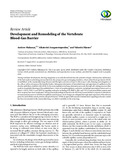| dc.contributor.author | Makanya, AN | |
| dc.contributor.author | Anagnostopoulou, Aikaterini | |
| dc.contributor.author | Djonov, Valentin | |
| dc.date.accessioned | 2013-07-25T06:32:43Z | |
| dc.date.available | 2013-07-25T06:32:43Z | |
| dc.date.issued | 2013 | |
| dc.identifier.citation | BioMed Research International Volume 2013 (2013), | en |
| dc.identifier.uri | http://www.hindawi.com/journals/bmri/2013/101597/ | |
| dc.identifier.uri | http://erepository.uonbi.ac.ke:8080/xmlui/handle/123456789/50864 | |
| dc.description.abstract | During vertebrate development, the lung inaugurates as an endodermal bud from the primitive foregut. Dichotomous subdivision of the bud results in arborizing airways that form the prospective gas exchanging chambers, where a thin blood-gas barrier (BGB) is established. In the mammalian lung, this proceeds through conversion of type II cells to type I cells, thinning, and elongation of the cells as well as extrusion of the lamellar bodies. Subsequent diminution of interstitial tissue and apposition of capillaries to the alveolar epithelium establish a thin BGB. In the noncompliant avian lung, attenuation proceeds through cell-cutting processes that result in remarkable thinning of the epithelial layer. A host of morphoregulatory molecules, including transcription factors such as Nkx2.1, GATA, HNF-3, and WNT5a; signaling molecules including FGF, BMP-4, Shh, and TFG-β and extracellular proteins and their receptors have been implicated. During normal physiological function, the BGB may be remodeled in response to alterations in transmural pressures in both blood capillaries and airspaces. Such changes are mitigated through rapid expression of the relevant genes for extracellular matrix proteins and growth factors. While an appreciable amount of information regarding molecular control has been documented in the mammalian lung, very little is available on the avian lung | en |
| dc.language.iso | en | en |
| dc.publisher | BioMed Research International | en |
| dc.title | Development and Remodeling of the Vertebrate Blood-Gas Barrier | en |
| dc.type | Article | en |
| local.publisher | Department of Veterinary Physiology, College of Agriculture and Veterinary Sciences, University of Nairobi, Nairobi, Kenya | en |
| local.publisher | Institute of Anatomy, University of Bern, Baltzerstrasse 2, 3000 Berne, Switzerland | en |

